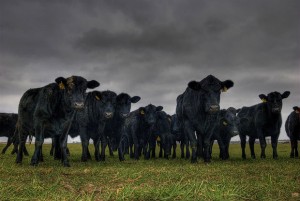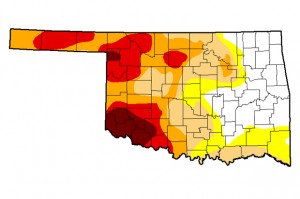As Beef Industry Deals With Drought, Researchers Eye Less-Thirsty Cattle
-
Logan Layden

Soonerpa / Flickr
The ongoing drought in Oklahoma affects everyone in the country. Well, everyone who likes to eat beef, that is. Beef and veal prices will have risen by about 11.5 percent in 2014, and, as Reuters reports, “will increase significantly again in 2015” because of drought in the Southern Plains.
Drought dries up ponds and has forced ranchers to reduce the size of their herds since the current drought began four years ago. But as The Oklahoman‘s Silas Allen reports, researchers from Oklahoma State University are using a $1 million grant from the U.S. Department of Agriculture to study how to make herds more resilient for future droughts:
Megan Rolf, an OSU animal scientist, said the purpose of the grant is two-fold.
Researchers are looking at the amount of feed and water certain breeds of cattle consume, with the long-term goal of developing cattle that are more adaptable to certain climate conditions, including drought.
The group is also working to expand the Mesonet’s cattle comfort index, a tool that shows ranchers how climate conditions are affecting their herds, she said.

U.S. Drought Monitor
The December 9 update of drought conditions in Oklahoma
Rolf says the breeds of cattle Oklahoma ranchers tend to prefer aren’t necessarily the best for Oklahoma’s climate, especially if it gets drier and hotter over the next half-century, as climate scientists predict.
The amount of feed and water cattle consume can vary widely depending on the breed, Rolf said. Brahman and other cattle that were bred for tropical climates tend to do well on less water, she said. But those breeds haven’t gained favor among ranchers in the United States.
“We don’t really use those breeds very much here in the U.S., for a variety of reasons,” Rolf said.
Eventually, researchers hope to develop cattle that consume less water, while keeping the meat quality and other characteristics that have made breeds like Angus and Hereford popular in the United States, Rolf said.
Recent wet weather has meant an improvement in drought conditions in Oklahoma, with about a quarter of the state — mainly in the east — completely drought free, and the worst of the drought remaining in southwest Oklahoma. That information is as of Dec. 11, prior to this past weekend’s abundant rainfall.
